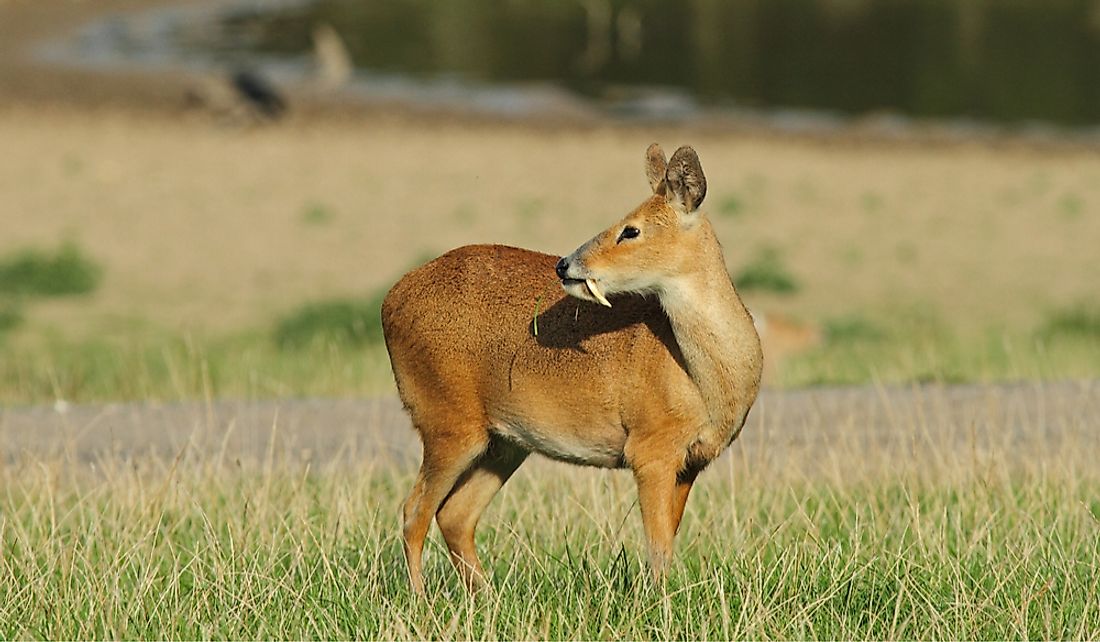Water Deer Facts - Animals of Asia

The water deer is a small species of the deer family that resembles more of a musk deer than an actual deer. It is native to China and the Korean peninsula. The two subspecies of the water deer are the Korean water deer and the Chinese water deer. They are considered cervids although they lack the antlers and the prominent tusks. The water deer is seriously threatened in their native habitats due to poaching and habitat destruction. In some areas, they are hunted for food, and in others, they are treated as an agricultural pest that should be eliminated.
4. Behavior
Water deer are antisocial; they prefer solitary lives away from another animal. Males are territorial and mark out territory using feces and urine. They also bite off parts of vegetations to mark boundaries. Although the males have long canines, they are not related to the carnivorous. They use their tusks as weapons during territorial and mating fights. The loser of a contest is chased out of the territory and is not allowed to mate with any female within the boundary. Females are only territorial during the mating season, but when the season ends, they can be seen wandering in an out of other territories. They may be found feeding in groups of unrelated members that will disperse at the sign of danger. Females are aggressive towards other deer before and after birth. They emit the barking sound that is interpreted as an alarm, sound of distress, or a warning.
3. Habitat and Range
The water deer is native to the Yancheng coastal wetlands, the lower regions of the Yangtze River, and the islands of Zhejiang. The demilitarized zone provides a protected habitat for large herds to thrive. They once roamed western and southern China but are currently extinct in these regions. The North Korean population is thriving because of the well-conserved forests and wetlands. They inhabit the riverbanks and marshes where the rushes and tall reeds serve as food and protection from predators and poachers. They are excellent swimmers and can swim for long to reach remote islands. The Korean population was once considered vulnerable by the IUCN, but the extinction of predators especially the leopards and the Korean tigers led to a resurgence in the population. Today, Chinese water deer are also found in Argentina, France, the United States, and the United Kingdom.
2. Diet
The primary diet of the water deer consists of grass, sedges, reeds, and other wetland plants. The availability of the food influences their habitats, but those inhabiting the wetlands have a more diverse diet than those inhabiting the grasslands. Occasionally, the grasslands are subjected to fire to stimulate the development of new shoots. The long canines of the males are flexible and help the animal grip better.
1. Physical Description
The water deer has a long neck, long legs, and narrow pelvic and pectoral girdles. The hind legs are slightly longer and powerful than the front. Their short tails of between 1.9 and 3.8 inches are barely visible while their ears are short and rounded. Their coats are golden brown with interspersed black hairs. Their coats turn thicker and coarse-haired during the winter to keep the animal warm. The young ones are born with dark brown coats. Males have long protruding canines that originate from the upper jaw and resemble the canines of the musk deer. The canines can grow to about 2.1 inches. During a conflict, the deer contracts the lower lip, and with the canines erect moves closer. A mature water deer stands 2.5-3.3 ft and weights anything between 20 and 31 lbs.











